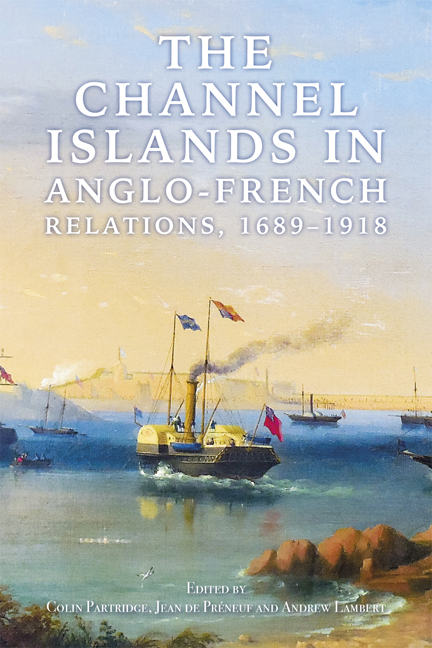Book contents
- Frontmatter
- Dedication
- Contents
- List of Illustrations
- List of Contributors
- Preface
- Introduction: ‘The Ehrenbreitstein of the English Channel’
- Part 1 Corsairs – the Ancien Régime and French Wars from 1689
- Part 2 The Islands – French and British Intelligence from the Seven Years War to 1815
- Part 3 Territorial Waters – the Land and Sea Interface from the 17th to 20th Centuries
- Part 4 Engineering Strategic Change
- Part 5 Alderney and the Channel Islands – Naval Strategy from 1815 to 1905
- Part 6 Civil Societies and Anglo-French Naval Rivalry – the 19th Century to WWI
- Part 7 Trade War – the Protection of Channel Islands Shipping in the Great War
- Afterword: Alderney, The Channel Islands, and the Study of History
- Bibliography
- Index
9 - Hydrographic and Nautical Knowledge in French Coastal- Defence Strategy: the Case of the Channel Islands Area
Published online by Cambridge University Press: 15 May 2024
- Frontmatter
- Dedication
- Contents
- List of Illustrations
- List of Contributors
- Preface
- Introduction: ‘The Ehrenbreitstein of the English Channel’
- Part 1 Corsairs – the Ancien Régime and French Wars from 1689
- Part 2 The Islands – French and British Intelligence from the Seven Years War to 1815
- Part 3 Territorial Waters – the Land and Sea Interface from the 17th to 20th Centuries
- Part 4 Engineering Strategic Change
- Part 5 Alderney and the Channel Islands – Naval Strategy from 1815 to 1905
- Part 6 Civil Societies and Anglo-French Naval Rivalry – the 19th Century to WWI
- Part 7 Trade War – the Protection of Channel Islands Shipping in the Great War
- Afterword: Alderney, The Channel Islands, and the Study of History
- Bibliography
- Index
Summary
The waters around the Channel Islands and the Gulf of Saint-Malo are known to be dangerous. Treacherous rocks that scatter the sea and strong tides produce rapid currents.
The weather is frequently difficult, and fogs are not unusual. The need for accurate charts drawn at an appropriate scale and precise nautical instructions appears then to be quite obvious. The French hydrographic service, known during the major part of the nineteenth century as the Dépôt des cartes et plans de la Marine before changing in 1886 to the Service hydrographique, made efforts to provide seamen with a collection of documents of great quality.
It is interesting to explore further the sequence of the different surveys and to replace them in their political and economic context whenever possible. It creates a rather contradictory image. The maritime activities whose prosperity was the final aim of these efforts were languishing during the nineteenth century. The harbours of the western coasts of Cotentin Peninsula and northern Brittany were lagging behind, unable to make the necessary investments in order to attract freight. Saint-Malo missed out on industrial development and never regained its former grandeur from the previous century. The port collapsed and did not even rank among the first twenty in France. Granville, despite some improvements and the construction of two wet docks in 1856 and 1873, never emerged and remained a fishing port. Few coasters exploited the sea routes between Cherbourg and the harbours of Brittany. Moreover, the trade that was mostly made up of agricultural products was in the hands of British shipowners and businessmen. They enjoyed preferential terms and prospered on the commercial relationships between France and the Channel Islands.
There were few shipowners in this area, and they concentrated mostly on high-sea fishing on the Grand Banks and in Iceland. This activity was more rewarding and attracted the major part of the available capital and able seamen. The port of Granville held 50 fishing boats, Saint-Malo nearly 70 and Saint- Brieuc 60 in 1866. The activity employed at that time almost 7,500 people. Coastal fishing was by comparison fruitless. Every year the statistics bulletin3 described the fishing practices as a routine and regretted that fishermen lacked a spirit of enterprise. With limited access to capital, they could only have small day boats and dredgers.
- Type
- Chapter
- Information
- The Channel Islands in Anglo-French Relations, 1689-1918 , pp. 173 - 194Publisher: Boydell & BrewerPrint publication year: 2024



